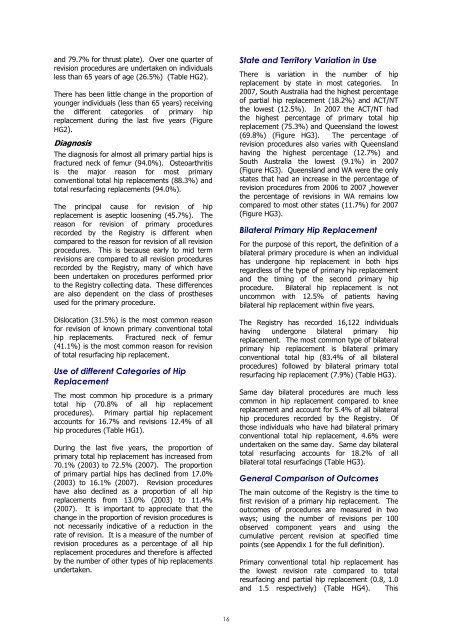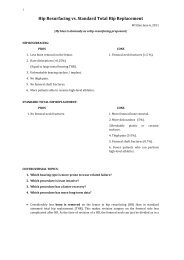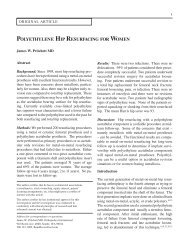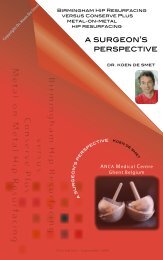Hip and Knee Arthroplasty - Surface Hippy Guide to Hip Resurfacing
Hip and Knee Arthroplasty - Surface Hippy Guide to Hip Resurfacing
Hip and Knee Arthroplasty - Surface Hippy Guide to Hip Resurfacing
Create successful ePaper yourself
Turn your PDF publications into a flip-book with our unique Google optimized e-Paper software.
<strong>and</strong> 79.7% for thrust plate). Over one quarter of<br />
revision procedures are undertaken on individuals<br />
less than 65 years of age (26.5%) (Table HG2).<br />
There has been little change in the proportion of<br />
younger individuals (less than 65 years) receiving<br />
the different categories of primary hip<br />
replacement during the last five years (Figure<br />
HG2).<br />
Diagnosis<br />
The diagnosis for almost all primary partial hips is<br />
fractured neck of femur (94.0%). Osteoarthritis<br />
is the major reason for most primary<br />
conventional <strong>to</strong>tal hip replacements (88.3%) <strong>and</strong><br />
<strong>to</strong>tal resurfacing replacements (94.0%).<br />
The principal cause for revision of hip<br />
replacement is aseptic loosening (45.7%). The<br />
reason for revision of primary procedures<br />
recorded by the Registry is different when<br />
compared <strong>to</strong> the reason for revision of all revision<br />
procedures. This is because early <strong>to</strong> mid term<br />
revisions are compared <strong>to</strong> all revision procedures<br />
recorded by the Registry, many of which have<br />
been undertaken on procedures performed prior<br />
<strong>to</strong> the Registry collecting data. These differences<br />
are also dependent on the class of prostheses<br />
used for the primary procedure.<br />
Dislocation (31.5%) is the most common reason<br />
for revision of known primary conventional <strong>to</strong>tal<br />
hip replacements. Fractured neck of femur<br />
(41.1%) is the most common reason for revision<br />
of <strong>to</strong>tal resurfacing hip replacement.<br />
Use of different Categories of <strong>Hip</strong><br />
Replacement<br />
The most common hip procedure is a primary<br />
<strong>to</strong>tal hip (70.8% of all hip replacement<br />
procedures). Primary partial hip replacement<br />
accounts for 16.7% <strong>and</strong> revisions 12.4% of all<br />
hip procedures (Table HG1).<br />
During the last five years, the proportion of<br />
primary <strong>to</strong>tal hip replacement has increased from<br />
70.1% (2003) <strong>to</strong> 72.5% (2007). The proportion<br />
of primary partial hips has declined from 17.0%<br />
(2003) <strong>to</strong> 16.1% (2007). Revision procedures<br />
have also declined as a proportion of all hip<br />
replacements from 13.0% (2003) <strong>to</strong> 11.4%<br />
(2007). It is important <strong>to</strong> appreciate that the<br />
change in the proportion of revision procedures is<br />
not necessarily indicative of a reduction in the<br />
rate of revision. It is a measure of the number of<br />
revision procedures as a percentage of all hip<br />
replacement procedures <strong>and</strong> therefore is affected<br />
by the number of other types of hip replacements<br />
undertaken.<br />
State <strong>and</strong> Terri<strong>to</strong>ry Variation in Use<br />
There is variation in the number of hip<br />
replacement by state in most categories. In<br />
2007, South Australia had the highest percentage<br />
of partial hip replacement (18.2%) <strong>and</strong> ACT/NT<br />
the lowest (12.5%). In 2007 the ACT/NT had<br />
the highest percentage of primary <strong>to</strong>tal hip<br />
replacement (75.3%) <strong>and</strong> Queensl<strong>and</strong> the lowest<br />
(69.8%) (Figure HG3). The percentage of<br />
revision procedures also varies with Queensl<strong>and</strong><br />
having the highest percentage (12.7%) <strong>and</strong><br />
South Australia the lowest (9.1%) in 2007<br />
(Figure HG3). Queensl<strong>and</strong> <strong>and</strong> WA were the only<br />
states that had an increase in the percentage of<br />
revision procedures from 2006 <strong>to</strong> 2007 ,however<br />
the percentage of revisions in WA remains low<br />
compared <strong>to</strong> most other states (11.7%) for 2007<br />
(Figure HG3).<br />
Bilateral Primary <strong>Hip</strong> Replacement<br />
For the purpose of this report, the definition of a<br />
bilateral primary procedure is when an individual<br />
has undergone hip replacement in both hips<br />
regardless of the type of primary hip replacement<br />
<strong>and</strong> the timing of the second primary hip<br />
procedure. Bilateral hip replacement is not<br />
uncommon with 12.5% of patients having<br />
bilateral hip replacement within five years.<br />
The Registry has recorded 16,122 individuals<br />
having undergone bilateral primary hip<br />
replacement. The most common type of bilateral<br />
primary hip replacement is bilateral primary<br />
conventional <strong>to</strong>tal hip (83.4% of all bilateral<br />
procedures) followed by bilateral primary <strong>to</strong>tal<br />
resurfacing hip replacement (7.9%) (Table HG3).<br />
Same day bilateral procedures are much less<br />
common in hip replacement compared <strong>to</strong> knee<br />
replacement <strong>and</strong> account for 5.4% of all bilateral<br />
hip procedures recorded by the Registry. Of<br />
those individuals who have had bilateral primary<br />
conventional <strong>to</strong>tal hip replacement, 4.6% were<br />
undertaken on the same day. Same day bilateral<br />
<strong>to</strong>tal resurfacing accounts for 18.2% of all<br />
bilateral <strong>to</strong>tal resurfacings (Table HG3).<br />
General Comparison of Outcomes<br />
The main outcome of the Registry is the time <strong>to</strong><br />
first revision of a primary hip replacement. The<br />
outcomes of procedures are measured in two<br />
ways; using the number of revisions per 100<br />
observed component years <strong>and</strong> using the<br />
cumulative percent revision at specified time<br />
points (see Appendix 1 for the full definition).<br />
Primary conventional <strong>to</strong>tal hip replacement has<br />
the lowest revision rate compared <strong>to</strong> <strong>to</strong>tal<br />
resurfacing <strong>and</strong> partial hip replacement (0.8, 1.0<br />
<strong>and</strong> 1.5 respectively) (Table HG4). This<br />
16






